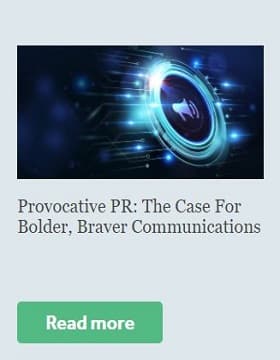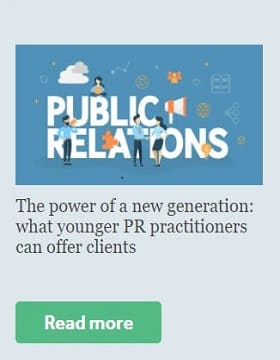
Building Your Company Profile Using LinkedIn PR

Building Reputation Capital in 2022
How NGO PR Can Increase Reach, Influence & Networks
1 December 2021

How NGOs can harness the power of PR to gain a competitive advantage
by Liz Lui, Account Manager, Sandpiper Hong Kong. Liz is experienced in brand and corporate communications and has worked with a number of global, blue chip healthcare companies and NGOs. She specialises in content and media relations strategies for multi-channel communications campaigns, stakeholder outreach, global webinars, executive training and more.
NGOs and PR have a natural affinity. Because NGOs champion important, community-driven and issues-rich causes, they have a valuable opportunity to generate media coverage to help influence public discussions and garner support.
The NGO space can be competitive. Unfortunately, while most NGOs are great at fundraising and smaller-scale community activities, not all are as proficient at using PR and media relations to help them sustain visibility and build brand affinity, which can lend itself to longer-term — as opposed to one-off — support and investment . It’s important for NGOs to prioritise PR, because it presents an opportunity to:
enhance gain further awareness for their cause
contribute to the public discussion
stand out in a competitive landscape
establish authority and trust
network and connect with key opinion leaders and media connections
Put simply, NGOs have a tremendous opportunity to further their cause with PR and media relations. However, this is often underutilised, even though it’s one of the most impactful and effective tactics in the marketing mix.
Building networks via NGO PR
NGOs need to establish and maintain relationships with valuable stakeholders, including government, potential donors and corporate collaborators. But how to get their attention? A strategic PR campaign can generate media coverage in the right outlets, to gain impactful attention with key opinion leaders.
In addition to your “story”, it is also worth thinking about your stakeholder audience’s behavior. For example, what media outlets do they consume? What programs do they watch, podcasts do they subscribe to, and which newspapers and magazines do they read, if any? Knowing where to find your target audience live in the media world will help you avoid shouting into the wind and maximize impact.
These days, media coverage has longer mileage, as news stories stay online in perpetuity, meaning there’s more power for people to discover older content — it’s evergreen. Media outlets themselves work harder to promote their content too, via social media. Important articles get shared, and reshared amongst your target stakeholders, providing a compounded level of interest and awareness derived from a single article. Follow this up with sustained media outreach and your NGO will soon become top of mind among your stakeholder audience.
Gaining trust as an NGO
Not all NGOs are equal, so it’s important to establish and maintain a reputation for your cause. Repeated and sustained media coverage can help educate your stakeholders about the importance of your issue. Furthermore, you can help demonstrate what you’re doing to make change and ideally, inspire action about how they can get involved too.
Not all NGOs are accredited, and some begin as ad hoc, grassroots campaigns which can be disorganised while they’re in infancy. Thus, strategic NGO PR can keep you top of mind and protect your space as one of the key players campaigning on the issue. Getting featured in a top-tier, well-respected publication will also lend credibility to your brand.
Newsjacking to leverage public issues
NGOs tend to be very low key, and potentially under-resourced when it comes to marketing. So PR remains a highly appealing option, as it is far more cost effective than expensive advertising campaigns on traditional or digital channels. One of the key ways NGOs can get a foot in the door with influential journalists, broadcast producers and podcasters is newsjacking. Essentially, this means piggy-backing off trending news topics to get media attention. When a key news story hits, journalists and producers will be seeking to interview experts on the subject. Clever NGOs who can be ready with a well-timed response and have spokespersons available for coverage can capitalise on this interest to generate valuable media coverage.
Using a variety of spokespeople
The key to solid media coverage is investing in your NGO spokespeople. Ideally, you’d have a variety of spokespeople who can:
talk about your cause with authority and credibility
articulate their points concisely
understand what media are looking for and deliver impactful soundbites
feel confident and relaxed when preparing for media interviews (which can be nerve wracking)
Like any other skill, the ability to perform well in media interviews comes with training and practice. Having a team of high-performing spokespeople who are available as much as possible for media interviews will help your NGO gain valuable column inches and is well worth the investment.
Building media relationships
Journalists, producers, bloggers and podcasters are all on the lookout for experts who can give them high-value content. If you can establish your NGO and its spokespersons as a reliable source, you can hope to be contacted repeatedly for expert commentary on important public issues. On the contrary, if you fail to understand media expectations and give them content they can’t use, they’ll look to other commentators next time a relevant news story arises.
You can help deliver journalists what they need by:
Being available quickly: media work to tight deadlines so need content delivered as quickly as possible – especially broadcast press, TV and radio
Giving strong opinions: sitting on the fence is dull, so be prepared to stake a firm opinion and give media impactful quotes
Backing up claims with data: media need to fact check, so if you can provide research to support your position, you will make their life much easier
Speaking in layman’s terms: not getting overly technical or using too much jargon
being concise: media are looking for brief soundbites and quotes, so it’s important to condense your message down to a few persuasive statements
Using storytelling: illustrate your position with evocative stories, ideally
providing access to people: the people struggling with the problem can share their lived experience and make meaningful stories, so facilitate introductions to thesepeople to give your story depth and human interestimagery, audio and vision: a powerful video reel or photographic series can enhance placement in your broadcast or see you move from page 17 to page five, so explore how you can give media a complete story with visual appeal.
Sustained PR for NGOs
To be truly effective NGOs should consider PR a long-term, ongoing investment. Journalists come and go and news stories also have peaks and troughs of interest. So NGOs seeking to establish themselves as thought leaders should maintain a sustained program of continued media outreach to deepen existing relationships and forge connections with emerging media in both the traditional and digital landscape.
The benefits of PR for NGOs are considerable, so when implemented strategically, it presents an exciting opportunity to connect with audiences and ultimately, further your important cause.
You may also like:





